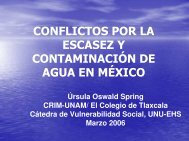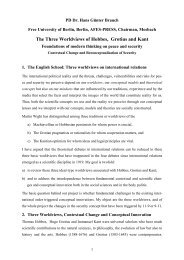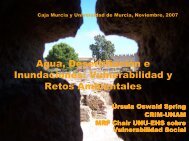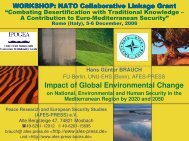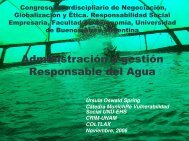Towards a Fourth Pillar of Human Security: âFreedom from Hazard ...
Towards a Fourth Pillar of Human Security: âFreedom from Hazard ...
Towards a Fourth Pillar of Human Security: âFreedom from Hazard ...
You also want an ePaper? Increase the reach of your titles
YUMPU automatically turns print PDFs into web optimized ePapers that Google loves.
©Hans Günter G<br />
Brauch<br />
Free University <strong>of</strong> Berlin, Otto-Suhr<br />
Suhr-Institute for Political Science<br />
United Nations University, Institute for Environment and <strong>Human</strong> <strong>Security</strong> S<br />
(UNU-EHS)<br />
Peace Research and European <strong>Security</strong> Studies (AFES-PRESS), Chairman<br />
<strong>Towards</strong> a <strong>Fourth</strong> <strong>Pillar</strong> <strong>of</strong> <strong>Human</strong> <strong>Security</strong>:<br />
„Freedom <strong>from</strong> <strong>Hazard</strong> Impacts“<br />
Addressing Global Environmental Change,<br />
Environmental Stress and Natural <strong>Hazard</strong>s<br />
<strong>Human</strong> <strong>Security</strong> Network<br />
International Symposium On Building and<br />
Synergizing Partnership for Global <strong>Human</strong><br />
<strong>Security</strong> and Development<br />
Bangkok, Thailand, 30-31 May 2006<br />
© NASA, NOAA: Asia and Indian sub-continent regional imagery, 2006.05.22 at 1330Z. Centerpoint Latitude: 7:19:07N Longitude:<br />
96:56:59E. The information provided here is public domain and may be used freely by the public.
<strong>Hazard</strong> Impacts <strong>of</strong> Tsunami <strong>of</strong> 26 Dec. . 2004<br />
regionally and for Thailand<br />
HUMAN TOLL for Thailand:<br />
• Number <strong>of</strong> fatalities: 8,212.<br />
(2,448 non-Thais <strong>of</strong> 37 count.)<br />
• No. <strong>of</strong> people missing: 2,817.<br />
• No. <strong>of</strong> displaced: 6,000.<br />
Worst natural disaster in 50-100 years.<br />
IMPACT ON VULNERABLE POPULATIONS<br />
•50,000 children were affected<br />
•estimated 1,480 children lost one or both parents.<br />
•More women than men were killed in the tsunami.<br />
•children more vulnerable to abuse, incl. sexual exploitation.<br />
DAMAGES AND LOSSES<br />
•Six southern provinces were severely impacted.<br />
•Over 120,000 individuals in tourism sector lost their jobs.<br />
•30,000 individuals employed in fisheries sector lost sources <strong>of</strong><br />
livelihood.<br />
•4,806 houses were affected. 3,302 were completely destroyed,<br />
and 1,504 were partially damaged.<br />
•Ca. 5,000 boats were lost or damaged.<br />
•2,000 hectares <strong>of</strong> agricultural land were destroyed.<br />
•305 acres <strong>of</strong> mangroves, 3,600 acres <strong>of</strong> coral, and 400<br />
seagrass beds were impacted.<br />
•102 large ponds, 2,321 wells, and two ground wells were<br />
contaminated.<br />
•The loss <strong>of</strong> income in the tourist industry is estimated to be $25<br />
million monthly.<br />
•The Thai Hotels Association estimated that hotel occupancy<br />
fell by 20 percent in 2005.<br />
FINANCIAL IMPLICATIONS<br />
•Losses: $1.6 billion and costs <strong>of</strong> repairing: $482 million.<br />
•$21.4 million was requested in humanitarian assistance<br />
•Thailand received $18 million, <strong>of</strong> which $7.5 million has been<br />
spent in Nov. 2005.<br />
•$38.3 million is being delivered in mid- to long-term recovery<br />
programming for 2005–06.
Contents<br />
1. Four <strong>Pillar</strong>s <strong>of</strong> <strong>Human</strong> <strong>Security</strong><br />
2. Freedom <strong>from</strong> <strong>Hazard</strong> Impacts<br />
3. PEISOR Model: Global Change, Environmental<br />
Stress and Extreme Outcomes<br />
4. Cause: Pressure <strong>of</strong> Global Environmental Change<br />
5. Effect: Environmental Scarcity, Degradation & Stress<br />
6. Global, Regional and National Impacts<br />
7. Policy Response: Reducing Social Vulnerability &<br />
Building Resilience<br />
8. Policy Task: Strengthening <strong>Human</strong> <strong>Security</strong> as Freedom<br />
From <strong>Hazard</strong> Impact<br />
9. Conclusions and Suggestions for Policy & Research<br />
10. <strong>Human</strong> <strong>Security</strong> Members, Goals and Proposal
1. Four <strong>Pillar</strong>s <strong>of</strong> <strong>Human</strong> <strong>Security</strong><br />
• “Freedom <strong>from</strong> fear” by reducing the probability that<br />
hazards may pose a survival dilemma for most affected<br />
people <strong>of</strong> extreme weather events (UNESCO,<br />
HSN), Canadian approach: <strong>Human</strong> <strong>Security</strong> Report<br />
Freedom <strong>from</strong> want” by reducing societal vulnerability<br />
through poverty eradication programmes (UNDP<br />
1994; CHS 2003: Ogata/Sen: <strong>Human</strong> <strong>Security</strong> Now),<br />
Japanese approach;<br />
• “Freedom to live in dignity” (K<strong>of</strong>i Annan in his<br />
report: In Larger Freedom (March 2005)<br />
• “Freedom <strong>from</strong> hazard impact” by reducing vulnerability<br />
& enhancing coping capabilities <strong>of</strong> societies<br />
confronted with natural & human-induced hazards<br />
(Bogardi/Brauch 2005; Brauch 2005a, 2005b).
1.1. First <strong>Pillar</strong> <strong>of</strong> HS: “Freedom From Fear”<br />
• Primary Focus <strong>of</strong> the <strong>Human</strong> <strong>Security</strong> Network<br />
• Requirements and objects:<br />
Rule <strong>of</strong> Law: ICC, International Court <strong>of</strong> Justice and<br />
national, regional and local judicial courts and mechanisms<br />
Universal <strong>Human</strong>itarian Standards: initiatives in international,<br />
humanitarian and human rights law, human development,<br />
human rights education,<br />
Good Governance: capacity building <strong>of</strong> not only national,<br />
but regional and local governments or leadership authorities;<br />
fostering democracy; respect for minorities<br />
Conflict Prevention/ Post-Conflict Reconstruction: land<br />
mines, child soldiers, protection <strong>of</strong> civilian population in<br />
armed conflict, small arms and light weapons, trans-national<br />
organized crime (Ottawa Convention on Anti-personnel<br />
Landmines)<br />
Strong International Institutions
1.2. “Freedom From Want”:<br />
<strong>Human</strong> <strong>Security</strong> Commission: <strong>Human</strong> <strong>Security</strong> Now<br />
• Broad: wider agenda, conceptually more convoluted<br />
• Goal: reducing individual/societal vulnerabilities in the economic,<br />
health, environment, political, community, and food sphere.<br />
Create conditions that can lead to empowerment for individuals,<br />
• Japanese FM: HS “comprehensively covers all menaces that<br />
threaten human survival, daily life, and dignity…and strengthens<br />
efforts to confront these threats.”<br />
• Threats:<br />
– diseases, poverty, financial crises, hunger, unemployment, crime,<br />
– social conflict, political repression,<br />
– land degradation, deforestation, emission <strong>of</strong> GHGs, environm. hazards,<br />
– population growth, migration, terrorism, drug production & trafficking.
1.3. “Freedom to Live in<br />
Dignity”<br />
• K<strong>of</strong>i Annan – need for a human<br />
centered approach to security<br />
“human security can no longer<br />
be understood in purely military<br />
terms.<br />
• It must encompass economic<br />
development, social justice,<br />
environmental protection,<br />
democratisation, disarmament,<br />
and respect for human rights and<br />
the rule <strong>of</strong> law.”<br />
• “Embraces far more than the<br />
absence <strong>of</strong> violent conflict”
2. “Freedom From <strong>Hazard</strong> Impacts”<br />
• UNU-EHS: Bogardi/Brauch (2005), Brauch (2005)<br />
• Goal: reduce vulnerabilities & enhance capacity building &<br />
coping capabilities <strong>of</strong> societies faced with natural hazards<br />
• Threats/<strong>Hazard</strong>s:<br />
– Environmental: floods, droughts, and other natural disasters, environmental<br />
degradation, lack <strong>of</strong> water or clean water, human-induced climate change,<br />
exhaustion <strong>of</strong> fish resources, depletion <strong>of</strong> finite resources (e.g. oil, gas)<br />
– Societal: poverty, improper housing, insufficient food and water, malfunctioning<br />
<strong>of</strong> technical systems, traffic accidents, population explosions, terrorism and<br />
organized crime<br />
• Develop vulnerability indicators and vulnerability mapping to apply to<br />
operational realm by working on solutions<br />
– improved early warning systems & capacity-building for early warning<br />
– disaster preparedness (education and training, infrastructure)<br />
– coordinated rapid disaster response by local, regional and national level<br />
– developing clear guidelines for post hazard reconstruction<br />
– long term strategies: e.g. Kyoto, Montreal Protocol<br />
– adaptation measures: e.g. dams, switching to renewable energy<br />
– mitigation measures: restrict housing in hazard areas (coastal areas-flooding,<br />
mud slides), charging more for garbage disposal and energy usage, birth control<br />
measures
3. PEISOR Model: Global Change, Envi-<br />
ronmental Stress & Extreme Outcomes<br />
• The model distinguished 5 stages:<br />
P: Pressure: Causes <strong>of</strong> GEC : Survival hexagon<br />
E: Effect: environm. scarcity, degradation & stress<br />
I: Impact: Extreme or fatal outcome: hazards<br />
S: Societal Outcomes: disaster, migration, crisis,<br />
conflict, state failure etc.<br />
R: Response by the state, society, the economic<br />
sector and by using traditional and modern knowledge<br />
to enhance coping capacity and resilience
3.1. PEISOR Model: Global Change, Envi-<br />
ronmental Stress & Extreme Outcomes
4. Cause: Pressure <strong>of</strong> Global Environmental<br />
Change: Six Determinants: Survival Hexagon<br />
Ecosphere:<br />
• Air: Climate Change<br />
• Soil: Degradation,<br />
Desertification<br />
• Water: degradat./scarcity<br />
Anthroposphere:<br />
• Population growth/decline<br />
• Rural system: agriculture<br />
• Urban system: pollution etc.<br />
Mode <strong>of</strong> Interaction<br />
- Linear, Nonlinear<br />
- Exponential<br />
- Chaotic, abrupt
4.1. Global Climate Change:<br />
Temperature Increases & Sea Level Rise<br />
2 Climate Change Impacts: Temperature & Sea level Rise<br />
Global average temperature<br />
rise in 20 th century: + 0.6°C<br />
Proj. temperature rise:<br />
1990-2100: +1.4 – 5. 8°C<br />
Sources: IPCC 1990, 1995, 2001<br />
Sea level Rise:<br />
20 th cent.: +0,1-0,2 m<br />
21st century: 9-88 cm
4.2. Climate Change Poses Environmental<br />
‘Threats’, ‘Challenges’, ‘Vulnerabilities’ and<br />
‘Risks’ for National and <strong>Human</strong> <strong>Security</strong><br />
Environmental<br />
causes, stressors,<br />
effects &natural<br />
hazards pose<br />
Climate change<br />
- temperature<br />
increase<br />
(creeping, longterm)<br />
Climate change<br />
- sea level rise<br />
(creeping, longterm)<br />
Natural and economic factors<br />
Substantial<br />
threats for<br />
- <strong>Human</strong> health<br />
- agriculture<br />
(yield decline)<br />
- biodiversity<br />
-<br />
desertification<br />
- Small island<br />
states<br />
- marine ecosystem,<br />
- indigenous<br />
communities,<br />
- industry,<br />
energy<br />
Challenges<br />
affecting<br />
<strong>Security</strong> objects (for what or whom?)<br />
- tourism<br />
- food security<br />
- fisheries<br />
- government<br />
action<br />
- econ. action<br />
- deltas<br />
- coastal zones<br />
- marine,<br />
freshwater<br />
ecosystems<br />
Societal impact factors (exposure)<br />
Vulnerabilities for<br />
- infect. disease<br />
- damage to<br />
crops<br />
- natural systems<br />
- water scarcity<br />
- forest fire<br />
- coastal cities,<br />
habitats,<br />
infrastructure,<br />
jobs<br />
- cities, homes,<br />
jobs<br />
Risks for<br />
- human<br />
populations<br />
- the poor, old<br />
people and<br />
children due to<br />
heat waves<br />
- livelihood<br />
- poor people,<br />
- insurance,<br />
- financial<br />
services
4.3. Change in Probability <strong>of</strong> Hot Summers, 2020 and<br />
2080. Source: M. Parry, Meeting <strong>of</strong> EU Agriculture &<br />
Environment Ministers, 11.9.2005, London
4.4. Climate Change Impacts on Agriculture<br />
Source: © UNEP; GRID Arendal<br />
•
High Potential<br />
for Food Crisis<br />
(1901-1995)<br />
1995)<br />
© Alcamo/Endejan<br />
2002: 143<br />
4.5. Food Crises<br />
High Potential for<br />
Food Crisis (2001-<br />
2050) with GDP and<br />
Climate Change <br />
© Alcamo/Endejan 2002-143
4.6. FAO (2000) Increase in Cereal Imports<br />
• FAO: 4 March 2003,<br />
Rome World's population<br />
will be better fed by 2030,<br />
but hundreds <strong>of</strong> millions<br />
<strong>of</strong> people in develo-ping<br />
countries will remain<br />
chronically hungry.<br />
• Number <strong>of</strong> hungry people<br />
will decline <strong>from</strong> 800 million<br />
today to 440 million in<br />
2030.<br />
• The target <strong>of</strong> the World<br />
Food Summit (1996) to<br />
reduce the number <strong>of</strong><br />
hungry by half by 2015,<br />
will not be met by 2030.
4.7. Climate Change: A New National “<strong>Security</strong>”<br />
Challenge? Climate change may spark conflict<br />
• Britain's Defence Secretary, John Reid, pointed to violent collision<br />
between a rising world population & shrinking world water resource:<br />
global warming. Climate change may spark conflict between nations<br />
and British armed forces must be ready to tackle violence.<br />
• He forecast that violence and political conflict would become more<br />
likely in the next 20 to 30 years as climate change turned land into<br />
desert, melted ice fields and poisoned water supplies.<br />
• He … listed climate change alongside the major threats .. in future<br />
decades, incl. terrorism, demographic changes,global energy dem.<br />
• He warned <strong>of</strong> increasing uncertainty about the future <strong>of</strong> the countries<br />
least well equipped to deal with flooding, water shortages and valuable<br />
agricul-tural land turning to desert.<br />
• „We see uncertainty growing … about the geopolitical and human<br />
consequences <strong>of</strong> climate change. "Impacts such as flooding, melting<br />
permafrost & desertification could lead to loss <strong>of</strong> agricultural land,<br />
poisoning <strong>of</strong> water supplies & destruc-tion <strong>of</strong> economic infrastructure.<br />
• "More than 300 million people in Africa currently lack access to safe<br />
water; climate change will worsen this dire situation.
4.8 Climate Change Poses<br />
Threats, Challenges, Vulnerabilities & Risks<br />
for <strong>Human</strong>, , National, Food & Health <strong>Security</strong><br />
• Globally: past trends & future projections<br />
– Temperature increase and change in precipitation<br />
– Increase in both flash floods & droughts<br />
– <strong>Hazard</strong> impacts depend also on social vulnerability and resilience<br />
– Response requires both protection & empowerment <strong>of</strong> the people<br />
• Regionally for South & Southeast Asia<br />
– potential increases in flash floods & drought<br />
– Impact on decline in crop yields (food security)<br />
• Climate Change Impacts on <strong>Human</strong> <strong>Security</strong><br />
– Increase im temperature (flash floods & droughts) & sea level rise poses a +<br />
– „survival dilemma“ for affected poor people in the South:<br />
a) to stay at home and to protect property (women, children, old p.)<br />
b) to leave their home and to move to mega cities (metro poles)<br />
c) to fight for the access to water (nomads in Sahel countries)<br />
• Conceptual Response is HUGE (U. Oswald Spring, Mexico)<br />
– <strong>Human</strong>, Gender and Environmental <strong>Security</strong><br />
a) to cope with survival dilemma <strong>of</strong> the victims <strong>of</strong> Global Environm. Change<br />
b) to develop survival strategies
5. Effect: Environmental Scarcity,<br />
Degradation & Stress<br />
Four Phases <strong>of</strong> Env. Sec, Research since 1983<br />
First Phase: Conceptual Phase: Concept Environmental <strong>Security</strong><br />
Second Phase: Empirical Phase: Case studies: Scarcity - Conflict<br />
Toronto: Homer-Dixon: since 1991: 3 Projects (figure © Homer-Dixon 1998)<br />
Zürich/Bern: Günther Bächler, K. Spillmann: environm. scarcity & degradation<br />
Third Phase: Manifold Research without Integration (1995 - pres.)<br />
Fouth Phase: Focus: interaction <strong>of</strong> environmental scarcity, degradation & stress
6. Global, Regional, National Impacts:<br />
<strong>Human</strong>-Induced Natural <strong>Hazard</strong>s Drought,<br />
Famine and Societal Consequences<br />
Much knowledge on these factors:<br />
Drought, migration, crises, conflicts<br />
Lack <strong>of</strong> knowledge on linkages among<br />
fatal outcomes<br />
Drought & drought-ind. migration<br />
Famine & environm.-ind. migration<br />
Conflicts & conflict-induced migration<br />
Lack <strong>of</strong> knowledge on societal<br />
consequences: crises/conflicts<br />
Domestic/international crises/conflicts<br />
Environmentally or war-induced<br />
migration as a cause or consequence<br />
<strong>of</strong> crises and conflicts
6.1. Societal<br />
Outcomes:<br />
Knowledge on Linkages <strong>of</strong> Outcomes<br />
• What are consequences <strong>of</strong> climate change,<br />
desertification and water scarcity for:<br />
– Environmental scarcity<br />
– Envivironmental degradation<br />
– Environmental stress?<br />
• What are indirect Societal Outcomes <strong>of</strong>:<br />
– <strong>Human</strong>-induced hydro-meteorological natural hazards<br />
(Storms, floods, landslides, drought) due to natural variability<br />
& increase due to climate change?<br />
– For migration, societal crises and domestic and international<br />
conflicts?
6.2. Global Impacts: Major Natural Disasters<br />
1950 – 2005. Source: MunichRe, , 2006<br />
© 2006 NatCatSERVICE, GeoRisikoForschung, Münchener Rück<br />
16<br />
14<br />
Earthquake/Tsunami, Volcano<br />
Storm<br />
Floods<br />
Temperature extremes (e.g. heat wave, cold spill, forest fire .<br />
12<br />
10<br />
Anzahl<br />
8<br />
6<br />
4<br />
2<br />
0<br />
1950 1955 1960 1965 1970 1975 1980 1985 1990 1995 2000 2005
6.3. Major Natural <strong>Hazard</strong>s (1950-2005),<br />
Economic and Insured Losses<br />
200<br />
© 2006 NatCatSERVICE, GeoRisikoForschung, Münchener Rück<br />
Billion US$<br />
180<br />
160<br />
140<br />
120<br />
100<br />
Economic Damages<br />
(in values <strong>of</strong> 2005)<br />
Insured damages<br />
(in values <strong>of</strong> 2005)<br />
Trends <strong>of</strong> Economic damages<br />
Trends <strong>of</strong> insured damages<br />
80<br />
60<br />
40<br />
20<br />
0<br />
1950 1955 1960 1965 1970 1975 1980 1985 1990 1995 2000 2005
6.4. Major Natural <strong>Hazard</strong>s (1950-2005).<br />
Source: Munich Re Research Div., 2006<br />
267 Events<br />
1,75 Million Dead<br />
6%<br />
25%<br />
29%<br />
40%<br />
Geological events<br />
Earthquake/Tsunami,<br />
Volcano<br />
Weather-related events<br />
Storm<br />
Floods<br />
Extreme temperatures<br />
36%<br />
7% 2%<br />
55%<br />
Volkswirtschaftliche Schäden: 1.700 Mrd. US$*<br />
6%<br />
25% 31%<br />
Versicherte Schäden: 340 Mrd. US$*<br />
5%<br />
11%<br />
5%<br />
38%<br />
79%<br />
*in Werten von 2005<br />
© 2006 GeoRisikoForschung, Münchener Rück
6.5. Reported Death <strong>of</strong> Natural <strong>Hazard</strong>s<br />
globally (1974-2003): 2.066.273 persons<br />
Source: © Hoyois und Guha-Sapir<br />
(2004)
6.6. Affected persons <strong>of</strong> Natural <strong>Hazard</strong>s<br />
globally (1974-2003): 5 076 494 541 persons<br />
Source: © Hoyois und Guha-Sapir<br />
(2004)
6.7. Natural <strong>Hazard</strong>s in Thailand<br />
(Source<br />
CRED: number <strong>of</strong> people killed)<br />
Disaster<br />
Date<br />
Total Killed<br />
Wave/Surge (Tsunami)<br />
Wind Storm<br />
Flood<br />
Wave/Surge<br />
Wind Storm<br />
Flood<br />
Flood<br />
Flood<br />
Flood<br />
Flood<br />
26-Dec-2004<br />
27-Oct-1962<br />
19-Nov-1988<br />
June 1955<br />
3-Nov-1989<br />
3-Jan-1975<br />
8-Sep-1995<br />
28-Oct-1995<br />
Oct-2002<br />
8-Aug-2001<br />
8,345<br />
769<br />
664<br />
500<br />
458<br />
239<br />
231<br />
200<br />
154<br />
104
6.8. Natural <strong>Hazard</strong>s in Thailand<br />
(Source<br />
CRED: number <strong>of</strong> people affected)<br />
Disaster<br />
Date<br />
Total Affected<br />
Drought<br />
Flood<br />
Drought<br />
Flood<br />
Flood<br />
Flood<br />
Drought<br />
Flood<br />
Wind Storm<br />
Flood<br />
Jan-1999<br />
<br />
<br />
8-Sep-1995<br />
Oct-2002<br />
3-Jan-1975<br />
Mar-1991<br />
Jul-2000<br />
17-Aug-1991<br />
Aug-1978<br />
6,000,000<br />
5,000,000<br />
5,000,000<br />
4,280,984<br />
3,289,420<br />
3,000,093<br />
2,500,000<br />
2,500,000<br />
1,894,238<br />
1,628,400
6.9. Natural <strong>Hazard</strong>s in Thailand<br />
(Source<br />
CRED: Economic damage costs)<br />
Disaster<br />
Date<br />
Damage US$ (000's)<br />
Flood<br />
Wind Storm<br />
Drought<br />
Wave/Surge (Tsunami)<br />
Flood<br />
Flood<br />
Flood<br />
Flood<br />
Flood<br />
Flood<br />
27-Nov-1993<br />
3-Nov-1989<br />
Jan-2005<br />
26-Dec-2004<br />
Dec-1993<br />
400,100<br />
19-Jan-1984<br />
28-Oct-1995<br />
31-Oct-1993<br />
Jul-1994<br />
1,261,000<br />
452,000<br />
420,000<br />
405,200<br />
400,100<br />
400,000<br />
400,000<br />
400,000<br />
319,850<br />
238,000
6.10. Summarized Table <strong>of</strong> Natural Disasters<br />
in Thailand (1955-2005)<br />
Source: EM<br />
: EM-DAT, CRED, Univ. <strong>of</strong> Louvain, Belgium<br />
#<br />
ev.<br />
Killed<br />
Homeless<br />
Injured<br />
Affected<br />
Total<br />
affected<br />
Damage<br />
US (‚000)<br />
Drought<br />
5<br />
0<br />
0<br />
0<br />
13,500,000<br />
13,500,000<br />
424,300<br />
Earthquake<br />
1<br />
0<br />
0<br />
0<br />
0<br />
0<br />
0<br />
Epidemic<br />
5<br />
212<br />
0<br />
0<br />
4,765<br />
4,765<br />
0<br />
Floods<br />
49<br />
2,503<br />
4.085<br />
163,283<br />
27,277,515<br />
27,444,883<br />
4,598,651<br />
Slides<br />
2<br />
42<br />
5<br />
0<br />
750,100<br />
750,100<br />
0<br />
Wave/Surge<br />
Tsunami<br />
4<br />
8,876<br />
8,457<br />
200<br />
58,550<br />
67,207<br />
405,467<br />
Wind Storm<br />
25<br />
1,478<br />
20<br />
108,137<br />
3,063,248<br />
3,171,405<br />
674,539
6.11. Global & National Trends: Climate<br />
Change and Climate-induded<br />
induded <strong>Hazard</strong>s<br />
Due to climate change model projections:<br />
• Average temperature will rise<br />
• Sea-level will rise<br />
• Hydro-meteorological events increase in<br />
number and economic damage<br />
But number <strong>of</strong> victims & affected depends on:<br />
• Degree <strong>of</strong> social vulnerability<br />
• Economic resources & level <strong>of</strong> poverty<br />
• Empowerment, resilience <strong>of</strong> affected people
7. Policy Response: Reducing Social<br />
Vulnerability & Building Resilience<br />
• To environmental scarcity, degradation & stress:<br />
– Proactive climate policy: reduce greenhouse gases by shifting to nonfossil<br />
energy resources, especially renewables<br />
– Combat desertification and soil erosion:<br />
– Cope with water scarcity & degradation by demand-side mana-gement and<br />
alternative supply (desalination with renewables)<br />
– Cope with population growth, rural emigation and urbanisation<br />
• To extreme outcomes <strong>of</strong> GEC, hydro-meteorological hazards<br />
& severe societal consequences:<br />
– Reducing the hazard impact by enhanced early warning against multiple<br />
hazards and reducing social vulnerability by improved resilience<br />
– Improved policy <strong>of</strong> conflict resolution, prevention and adaptation and<br />
mitigation against challenges <strong>of</strong> GEC that may lead to conflicts<br />
(anticipatory learning & conflict avoidance)
Addressing: Poverty<br />
and Violence with <strong>Hazard</strong> Impacts<br />
7.1. Simultaneously Addressing<br />
• 4 pillars <strong>of</strong> human security address 4 related policy goals:<br />
– Freedom <strong>from</strong> fear: „violence“, conflicts & wars and the means to fight<br />
them, small & light weapons<br />
– Freedom <strong>from</strong> want: „poverty“, basic human needs<br />
– Freedom to live in dignity: „good governance“ and „human rights“<br />
– Freedom <strong>from</strong> hazard impacts: „social vulnerability“ and „resilience“<br />
• Policy strategies to address simultaneously: violence,<br />
poverty, human tights and hazard impacts<br />
– Violence in local, regional, national and international conflicts<br />
– Violence in complex emergencies where a hazard impacts on a conflict<br />
region: e.g. Vulcano in Goma, tsunami in Sri Lanca and Aceh<br />
– Where hazards cause, trigger, intensify or influence violent conflicts<br />
– These may be considered on the agenda <strong>of</strong> the <strong>Human</strong> <strong>Security</strong> Network
7.2. <strong>Human</strong> <strong>Security</strong> Commission:<br />
Aiming at Protection & Empowerment<br />
• Protection: key role <strong>of</strong> the state<br />
– Reducing physical vulnerability: shelters, dams etc.;<br />
– Building infrastructure;<br />
– Early Warning;<br />
– Disaster preparedness and rapid response.<br />
• Empowerment: role <strong>of</strong> the state and people<br />
– Reducing social vulnerability, e.g.habitats in hazard<br />
prone regions;<br />
– Local knowledge;<br />
– Citizens‘ participation;<br />
– Training and preparedness <strong>of</strong> residents.
8. Policy Task: Strengthening <strong>Human</strong> <strong>Security</strong><br />
as „Freedom<br />
From <strong>Hazard</strong> Impact“<br />
Bogardi/Brauch (2005): focus on the env. dimension <strong>of</strong> human security by trying<br />
• to mainstream both,<br />
• to contribute to the fourth phase <strong>of</strong> the environmental security debate,<br />
• to develop a new pillar <strong>of</strong> the HS concept as “freedom <strong>from</strong> hazard impact”<br />
• to strengthen prospects <strong>of</strong> a learning society & for improved human security.<br />
This requires mainstreaming efforts on scientific and political tracks on:<br />
• environmental dimension <strong>of</strong> human security (conceptualisation in scientific<br />
community),<br />
• a “paradigm shift” within the UN System <strong>from</strong> national towards a human security<br />
per-spective on environmental threats, challenges, vulnerabilities and risks (Brauch<br />
2005).<br />
For international organisations, a dual mainstreaming may be needed:<br />
• to incorporate a “human security” perspective into “environmental<br />
security initiatives”,<br />
– ENVSEC process <strong>of</strong> OSCE, UNEP, UNDP, and NATO<br />
– into the “green diplomacy” <strong>of</strong> the European Union launched at EC in Thessaloniki in June 2003; and,<br />
• to add a “environmental security dimension” on the agenda <strong>of</strong> the HSN<br />
– with a special focus on complex emergiencies<br />
– where violent conflicts and hazard impacts interact.
8.1. <strong>Towards</strong> a <strong>Fourth</strong> Phase <strong>of</strong><br />
Environmental <strong>Security</strong> Research<br />
Future research should combine: structural factors <strong>of</strong> GEC<br />
with extreme outcomes and conflict constellations.<br />
A fourth phase <strong>of</strong> social science research may aim at the<br />
following ten conceptual and policy goals:<br />
–Scientific Orientation and Approach<br />
• Grotian perspective, political geo-ecology, human security focus,<br />
• Coping with <strong>Security</strong> Dilemma (states) and Survival Dilemma (human beings)<br />
• Dual goal: Sustainable development & sustainable peace<br />
–Scientific Focus on Causes, Impacts & Extreme Outcomes <strong>of</strong> Global<br />
Environmental Change<br />
• Causes, outcomes., policy process, regional perspective<br />
–Policy Goals:<br />
• Policy Goals on Societal / Individual Level: ESS studies should foster strategies<br />
–reducing the impact <strong>of</strong> environmental stress,<br />
–decreasing the vulnerability & strengthening coping capacities & resilience.<br />
• Policy Goals on Communal, Sub-national, National and International Level: Strategies<br />
for coping with outcomes <strong>of</strong> environmental stress should be developed by<br />
– improving disaster preparedness and response and by<br />
–integrating disaster reduction into development planning.<br />
– Resolution, prevention & avoidance <strong>of</strong> violence should become a major policy goal.
8.2. <strong>Towards</strong> a <strong>Fourth</strong> <strong>Pillar</strong> <strong>of</strong> <strong>Human</strong><br />
<strong>Security</strong> as Freedom <strong>from</strong> <strong>Hazard</strong> Impact<br />
• Conceptual and policy task for UNU-EHS: to develop human security<br />
as “freedom <strong>from</strong> hazard impact”, contribute to it through capacitybuilding<br />
for early warning, vulnerability indicators, & mapping.<br />
• Natural hazards cannot be prevented, but their impact can be reduced<br />
by early warning and better disaster preparedness.<br />
• “Freedom <strong>from</strong> hazard impact” implies that people can mobilise their<br />
resources to address sustainable development goals rather than<br />
remain in the vicious cycle <strong>of</strong> the survival dilemma.<br />
• “freedom <strong>from</strong> hazard impact” requires hazard specific policies &<br />
combination <strong>of</strong> technical, organisational and political measures for:<br />
– Slow-onset hazards: sea-level & temperature increase (climate change<br />
– Rapid-onset hydro-meteorological hazards:<br />
– Rapid-onset geophysical hazards: earthquakes, tsunamis<br />
– Man-made disasters: technical, organisational, political
8.3. Achieving <strong>Human</strong> <strong>Security</strong> through Freedom<br />
<strong>from</strong> Fear, Want & <strong>Hazard</strong> Impact<br />
Source: J.Ganoulis, , UNESCO Chair INWEB, Greece<br />
based on Brauch, UNU-EHS (2005, 2005a)
8.4. Research Goals <strong>of</strong> UNU-EHS<br />
Vulnerability<br />
Assessment<br />
as Part <strong>of</strong><br />
Early Warning<br />
Flood Plains and Deltas/Droughts<br />
Urban Rural<br />
Internat. Flood<br />
Initiative Prog.<br />
(IFI/P)<br />
Voices <strong>of</strong> <strong>Human</strong><br />
(In) <strong>Security</strong><br />
Capacity Building<br />
(coping capacity)<br />
Awareness Raising:<br />
<strong>Hazard</strong>s-Risks-<br />
Vulnerabilities-<br />
Sustainable<br />
Development
9. Conclusions and Suggestions<br />
for Research & Policy<br />
for Research & Policy<br />
1. <strong>Security</strong> can no longer employ the state as the sole<br />
referent. States can no longer monopolize the<br />
security realm as they have in the past.<br />
2. <strong>Human</strong> <strong>Security</strong> depending on the perspective or<br />
very broadly is threatened by underdevelopment<br />
(freedom <strong>from</strong> want), violent conflict (freedom <strong>from</strong><br />
fear), and societal and natural hazards (freedom<br />
<strong>from</strong> hazard impacts)<br />
3. A greater attempt needs to be made to reach a<br />
consensus on more precise conceptual definitions<br />
and more importantly, better operationally practical<br />
measures<br />
4. Key Struggle for HS: to identify priority issues<br />
without becoming too outstretched and therefore<br />
operationally unfeasible.
9.1. Complex Emergencies<br />
Co-existence <strong>of</strong> hazards & conflicts: a challenge for<br />
international and humanitarian organizations<br />
• Tsunami impacted on two conflicts: Aceh & Sri Lanka<br />
• Kashmir Earthquake (2005) impacted on conflict region<br />
• Drought in Sahel zone has triggered small-scale violence<br />
• Earthquake (1985) in Mexico has led to political reform<br />
<br />
<br />
<br />
Complex Causal Linkages<br />
Existing conflicts increase the social vulnerability to hazards<br />
Severe hazards may cause disasters, migrations, crises & conflicts<br />
Two sides <strong>of</strong> environmental security: environmental conflict vs.<br />
peacemaking?<br />
No Joint Dialogue and Research between two<br />
Early Warning Communities on <strong>Hazard</strong>s and Conflicts<br />
• Two parallel approaches has operational consequences for customers<br />
• <strong>Human</strong>itarian Organisations: IFRC-RCS has to deal with both
9.2.<strong>Hazard</strong>s as a Cause <strong>of</strong> Conflict<br />
Coincidence between famine<br />
areas & conflicts<br />
Sudan:, coexistence <strong>of</strong> all problems:<br />
disastes, internal displacement,<br />
refugees and conflict<br />
• Famines, political unrest, and<br />
civil wars occur simultaneously<br />
in same countries & regions<br />
• Migration: rapid spread <strong>of</strong> diseases,<br />
especially AIDS.<br />
Social science research is<br />
needed on links among extreme<br />
& fatal out-comes: drought,<br />
famine, migration, crises &<br />
conflicts.
9.3. Impact <strong>of</strong> <strong>Hazard</strong>s on Conflicts<br />
Sri Lanka:<br />
Conflict unresolved, may intensify,<br />
disaster aid as a cause <strong>of</strong> conflict?<br />
Aceh: Post-Tsunami Peace?<br />
EU Commission as a peacemaker<br />
Aceh (Sumatra) fighting for 30 years.<br />
20o4: Most victims <strong>of</strong> Tsunami in Aceh<br />
15 August 2005: Indonesian government<br />
& rrebels <strong>from</strong> the Free Aceh<br />
Movement (Gam) have signed a peace<br />
deal aimed at ending their conflict
9.4. Two Early Warning Communities<br />
No Dialogue and Scientific Cooperation<br />
between two Early Warning Communities<br />
Early Warning <strong>of</strong> <strong>Hazard</strong> &<br />
Disaster Community<br />
• <strong>Hazard</strong> Early Warning Community<br />
– Science: Many<br />
– Practice: UN-OCHA, ECHO, DG Env.,<br />
Civil Protection<br />
– Networks: Provention Consortium<br />
(Geneva, IFRC)<br />
• Early Warning Conferences in<br />
Potsdam (1998), Bonn (2003, 2006)<br />
Users<br />
GEC & Geoscience Community<br />
UNISDR, UNDP, UNEP/DEWA<br />
UN-OCHA, ECHO, IFRC/RCS<br />
EU DG Dev., ECHO, DG Env., Civ.Prot.<br />
Early Warning <strong>of</strong> <strong>Hazard</strong>s<br />
Early Warning <strong>of</strong> Crises &<br />
Conflict Community<br />
International Crisis Group: Crisis<br />
Watch Database<br />
Swisspeace: FAST<br />
SIPRI: Early Warning Indicators<br />
CEWARN: Conflict Early Warning &<br />
Response Mechanism<br />
Carleton University: Country Indicators<br />
for Foreign Policy<br />
Users<br />
UNSG: Dep. for Peacekeeping<br />
UN-OCHA, ECHO, IFRC/RCS<br />
EU DG Relex (Conflict Prevention, crisis<br />
management, green diplomacy)<br />
Early Warning <strong>of</strong> Crises Conflict<br />
Joint Customer: <strong>Human</strong>itarian Community: OCHA, ECHO,<br />
International Red Cross and <strong>Human</strong>itarian Aid Groups
• Early Warning <strong>of</strong> <strong>Hazard</strong>s and Disasters<br />
– Earthquakes & Tsunamis: Charter<br />
– Floods & Storms: Weather Services<br />
– Drought & Famine: FAO, WFP, USAID et al.<br />
– Disease, Pandemics: WHO & nat. agencies<br />
• Early Warning <strong>of</strong> Crises and Conflicts<br />
– Refugees, Internal Displacement & Migration: UNHCR, IOM<br />
– Crises: press, research, intelligence agencies<br />
– Conflicts: press, research, intelligence agencies<br />
Advantages <strong>of</strong> linking early warning on disasters & conflicts<br />
Successful early warning <strong>of</strong> hazards will also mitigate conflicts<br />
Successful early warning <strong>of</strong> conflicts will reduce vulnerabulity to<br />
hazards<br />
Scientific dialogue and political cooperation is needed
9.6. From Research to Action:<br />
Enhancing Environmental & <strong>Human</strong> <strong>Security</strong><br />
<strong>Towards</strong> Environmental Conflict Avoidance<br />
• Primary Goal: address fatal outcomes <strong>of</strong> GEC: hazards and<br />
disasters, migration, crises & conflicts that may have been<br />
caused, triggered, induced, influenced by: a)<br />
environmental stress and b) extreme weather events,<br />
• Enhance Environmental <strong>Security</strong>: Address human beha-viour<br />
that contributes to GEC via climate change, soil degrada-tion,<br />
water pollution & scarcity: sustainable strategies<br />
• Enhance <strong>Human</strong> <strong>Security</strong>: address factors <strong>of</strong> GEC that challenge<br />
survival <strong>of</strong> individuals, families, villages, ethnic groups<br />
• Avoid Environmentally-induced Conflicts: address structural<br />
or causal factors (<strong>of</strong> Survival Hexagon), e.g. climate policy,<br />
combat desertification, cope with water stress.
10. <strong>Human</strong> <strong>Security</strong> Network Members & Goals<br />
NATO<br />
(4)<br />
Canada<br />
Greece<br />
land<br />
Netherlands<br />
Norway<br />
EU (6)<br />
Austria<br />
Ireland<br />
Slovenia<br />
Switzer-<br />
Third World (6)<br />
Chile<br />
Costa Rica<br />
Jordan<br />
Mali<br />
Thailand (chair)<br />
South Africa<br />
(observer)<br />
Anti-pers. Landmines, Intern. Criminal Court, protection<br />
<strong>of</strong> children in armed conflict, control <strong>of</strong><br />
small arms & light weapons, fight against transnat<br />
organized crime, human development, human<br />
rights educat., HIV/AIDS, implement. <strong>of</strong> intern. humanitarian<br />
& human rights law, conflict prevention<br />
So far no environmental security issues<br />
on the agenda <strong>of</strong> this HS-Network.<br />
<br />
<br />
<br />
<br />
<br />
<br />
<br />
<br />
! <br />
" <br />
#$% <br />
&' #()))$<br />
* + #())$<br />
& #())($<br />
, ' #())-$" <br />
# ()).$/ #())0$
10.1. Second <strong>Human</strong> <strong>Security</strong> Network<br />
Medium Term Workplan 2005 – 2008<br />
7th Ministerial Meeting,<br />
Ottawa, Canada, 18-20 May 2005<br />
Guiding Principles<br />
• emerging threats to people's safety ,<br />
security, well-being ;<br />
• identifying concrete areas for collective<br />
action on human security;<br />
• promoting greater understanding <strong>of</strong>, and<br />
support for, human security issues;<br />
• advancing human security issues at the<br />
regional level, through international<br />
negotiations & conf.<br />
Areas <strong>of</strong> Cooperation<br />
1) Effective multilateral institutions<br />
2) <strong>Human</strong> Rights<br />
3) Protection <strong>of</strong> civilians „armed conflict“<br />
4) Small arms, light weapons, landmines<br />
5) Women, Peace and <strong>Security</strong><br />
6) HIV-AIDS<br />
7) Poverty/People-centred Developm.<br />
• Poverty & underdevelopment are a source <strong>of</strong><br />
insecurity. Poor people are more exposed to<br />
a whole range <strong>of</strong> vulnerabilities, such as<br />
exclusion, discrimination, human rights viol.<br />
• Poor are more vulnerable to political &<br />
economic emergencies & violence; are<br />
powerless & lack necessary resources<br />
& access to critical life opportunities.<br />
• address challenges <strong>of</strong> securing basic<br />
human needs, linked to freedom <strong>from</strong><br />
want and freedom to live in dignity, with<br />
a attention to empowerment measures.
10.2. Concept paper <strong>of</strong> Thailand as chair <strong>of</strong> HSN:<br />
„<strong>Human</strong> Agenda: Partnership for <strong>Human</strong> <strong>Security</strong>"<br />
1. GUIDING PRINCIPLES<br />
• Continuity, Contribution, Constituency, Consistency<br />
2. OBJECTIVES<br />
• Effectiveness, Uniqueness, Visibility and Connectivity<br />
3. APPROACH<br />
• Thailand will take a holistic and balanced approach to human security that is based upon a realization<br />
<strong>of</strong> inter-linkages between freedom <strong>from</strong> fear and freedom <strong>from</strong> want as well as freedom to live in<br />
dignity.<br />
• Thailand will avoid creating a hierarchy <strong>of</strong> issues bearing in mind different perspectives, interests and<br />
priorities <strong>of</strong> respective members. The issues will instead be grouped into 3 thematic clusters as<br />
follows:<br />
• (1) Poverty, development and HIV/AIDS<br />
• (2) <strong>Human</strong> Rights and <strong>Human</strong>itarian Affairs<br />
• (3) Emerging Issues<br />
4. PRIORITY ISSUES FOR THAILAND<br />
• As lead country: HIV/AIDS , People-centred development ., Trafficking in persons, especially women<br />
and children<br />
• As partner:<br />
• Landmines , <strong>Human</strong> Rights Education
10.3. „Freedom<br />
<strong>from</strong> <strong>Hazard</strong> Impact“:<br />
„Emerging<br />
Issue“ for „People-centred<br />
Development“<br />
• As the only member <strong>of</strong> the HSN, Thailand was a victim<br />
<strong>of</strong> the Tsunami <strong>of</strong> 26 December 2006<br />
• The Tsunami was the worst natural hazard in Thailand<br />
during the past 50 years.<br />
• As an ASEAN Country Thailand is familiar with the<br />
complex emergency in Aceh, Sumatra.<br />
• 22-24 May 2006: Thailand had worst flash flood in 60<br />
years that affected more people than the Tsunami.<br />
• Which lessons can be learned <strong>from</strong> this experience for<br />
a „people-centred development“ that reduces the<br />
impact <strong>of</strong> natural hazards by reducing social<br />
vulnerability and enhancing resilience?<br />
• A new agenda item for the <strong>Human</strong> <strong>Security</strong> Network?
I thank the Foreign Ministry <strong>of</strong> Thailand for<br />
inviting me, for its hospitality and for giving<br />
me an opportunity to share with you<br />
my own emerging conceptual ideas.<br />
Thank you for your attention<br />
and patience.<br />
Text for download at:<br />
http://www.afespress.de/html/download_hgb.html<br />
Send your comments to:<br />
brauch@onlinehome.de



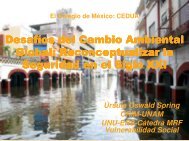
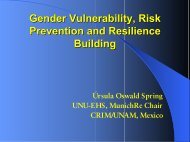
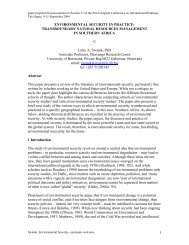
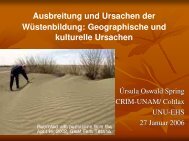


![Environmental security debates in Central Asia [and in Iran]: The ...](https://img.yumpu.com/48908494/1/184x260/environmental-security-debates-in-central-asia-and-in-iran-the-.jpg?quality=85)
